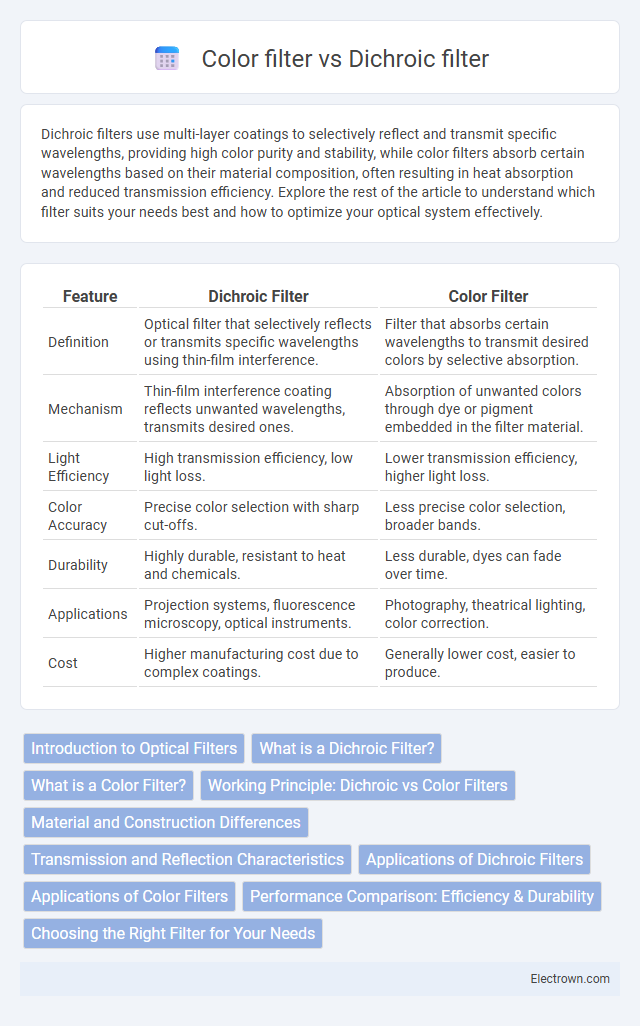Dichroic filters use multi-layer coatings to selectively reflect and transmit specific wavelengths, providing high color purity and stability, while color filters absorb certain wavelengths based on their material composition, often resulting in heat absorption and reduced transmission efficiency. Explore the rest of the article to understand which filter suits your needs best and how to optimize your optical system effectively.
Table of Comparison
| Feature | Dichroic Filter | Color Filter |
|---|---|---|
| Definition | Optical filter that selectively reflects or transmits specific wavelengths using thin-film interference. | Filter that absorbs certain wavelengths to transmit desired colors by selective absorption. |
| Mechanism | Thin-film interference coating reflects unwanted wavelengths, transmits desired ones. | Absorption of unwanted colors through dye or pigment embedded in the filter material. |
| Light Efficiency | High transmission efficiency, low light loss. | Lower transmission efficiency, higher light loss. |
| Color Accuracy | Precise color selection with sharp cut-offs. | Less precise color selection, broader bands. |
| Durability | Highly durable, resistant to heat and chemicals. | Less durable, dyes can fade over time. |
| Applications | Projection systems, fluorescence microscopy, optical instruments. | Photography, theatrical lighting, color correction. |
| Cost | Higher manufacturing cost due to complex coatings. | Generally lower cost, easier to produce. |
Introduction to Optical Filters
Optical filters manipulate light by selectively transmitting or reflecting specific wavelengths, enhancing image quality and color accuracy. Dichroic filters utilize thin-film interference coatings to reflect unwanted wavelengths while transmitting desired colors with high precision, offering superior spectral separation and efficiency. Color filters absorb certain wavelengths to produce color effects, providing a simpler but less precise option compared to dichroic filters in your optical or imaging applications.
What is a Dichroic Filter?
A Dichroic filter is an optical device that selectively reflects specific wavelengths of light while transmitting others, utilizing multiple thin-film layers to achieve precise spectral separation. Unlike conventional color filters that absorb unwanted wavelengths, dichroic filters provide high efficiency with minimal heat absorption and high durability. This makes them ideal for applications in photography, lighting, and scientific instruments where accurate color management and light control are essential.
What is a Color Filter?
A color filter is an optical filter that selectively transmits light of specific wavelengths while absorbing or reflecting others, allowing only certain colors to pass through. Unlike dichroic filters, which use interference coatings to reflect unwanted wavelengths and transmit desired ones with minimal absorption, color filters often rely on pigments or dyes that absorb non-target colors. Color filters are commonly used in photography, lighting, and scientific instruments to enhance contrast and isolate specific spectral bands.
Working Principle: Dichroic vs Color Filters
Dichroic filters operate using thin-film interference coatings that selectively reflect and transmit specific wavelengths of light, enabling precise spectral separation with minimal loss. Color filters rely on absorption principles, where pigments or dyes absorb unwanted wavelengths and transmit others, often resulting in reduced brightness and contrast. Your application benefits from dichroic filters' higher efficiency and sharper cutoff compared to traditional color filters, especially in optical instruments and imaging.
Material and Construction Differences
Dichroic filters are made from multiple thin layers of dielectric materials deposited on a glass substrate, enabling precise wavelength reflection and transmission through interference effects. Color filters typically use organic dyes or pigments embedded in a transparent substrate, absorbing specific wavelengths to produce color. The multilayer construction of dichroic filters allows for sharper spectral separation and higher durability compared to the simpler, absorption-based material of color filters.
Transmission and Reflection Characteristics
Dichroic filters utilize multilayer thin-film coatings to selectively reflect certain wavelengths while transmitting others with high precision and minimal absorption, resulting in superior spectral performance compared to traditional color filters. Color filters typically rely on dye or pigment absorption, which leads to broader transmission spectra and higher losses due to heat and light absorption. Understanding the distinct transmission and reflection characteristics of dichroic versus color filters allows you to choose the optimal solution for applications demanding precise wavelength separation and minimal energy loss.
Applications of Dichroic Filters
Dichroic filters are widely used in applications requiring precise wavelength selection, such as in fluorescence microscopy, optical instruments, and laser systems due to their ability to reflect specific wavelengths while transmitting others with minimal light loss. Unlike traditional color filters, dichroic filters provide superior spectral performance and durability, making them ideal for high-precision tasks in scientific research, photography, and theatrical lighting. Your optical system benefits from enhanced color separation and improved image clarity when incorporating dichroic filters.
Applications of Color Filters
Color filters are essential in various applications such as photography, stage lighting, and scientific imaging to selectively transmit specific wavelengths while blocking others, enhancing visual effects and color accuracy. Unlike dichroic filters that rely on interference coatings for precise wavelength reflection and transmission, color filters typically use dyed glass or plastics to absorb unwanted colors. Your choice of color filter can significantly impact image quality in optical instruments, sensory equipment, and display technologies.
Performance Comparison: Efficiency & Durability
Dichroic filters exhibit superior efficiency by reflecting specific wavelengths with minimal light absorption, resulting in higher color accuracy and brightness compared to traditional color filters that absorb unwanted colors. Their multi-layer dielectric coatings enhance durability, making dichroic filters resistant to heat, fading, and chemical damage, whereas color filters tend to degrade faster under prolonged exposure. Choosing a dichroic filter can significantly improve your optical system's performance through better light transmission and extended lifespan.
Choosing the Right Filter for Your Needs
Dichroic filters offer precise wavelength selection with high durability and efficiency, making them ideal for scientific instruments and advanced optical systems. Color filters provide broader color ranges and are cost-effective solutions commonly used in photography and lighting applications. Choosing the right filter depends on required spectral performance, budget constraints, and the specific use case demands.
Dichroic filter vs Color filter Infographic

 electrown.com
electrown.com